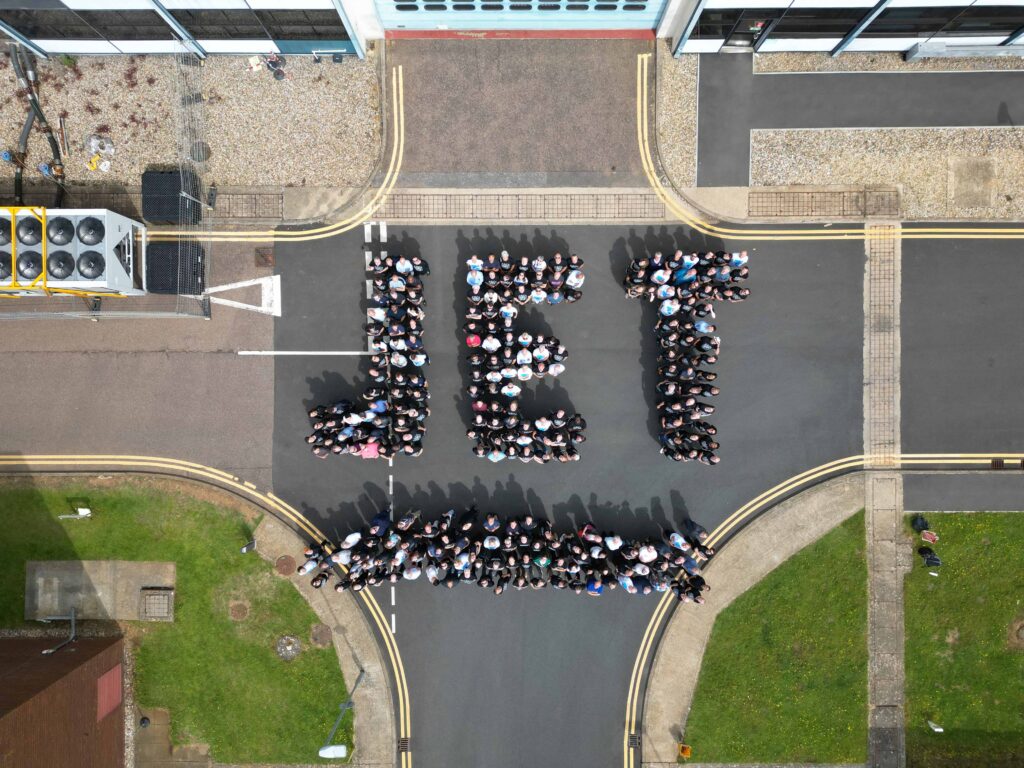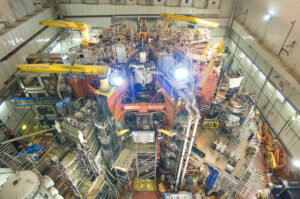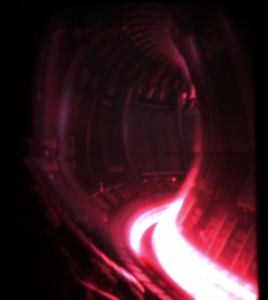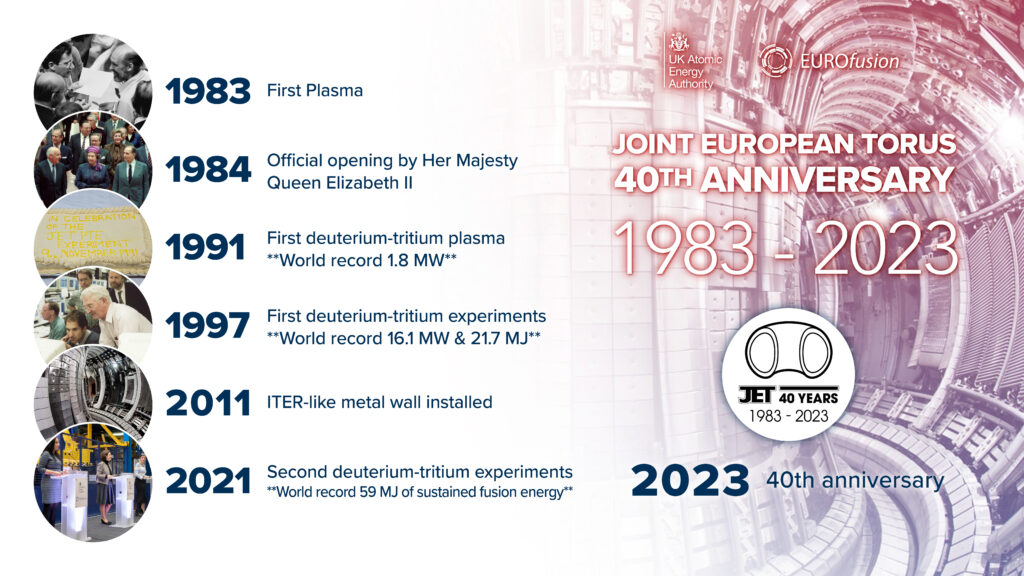
JET researchers and staff across Europe are celebrating this occasion today, two days ahead of the actual date of the 40th anniversary of JET’s first plasma on Sunday 25 June. A festive ceremony took place at the JET facility in the UK, featuring a group photo, speeches followed by a lunch, a special JET cake and an exhibition displaying 40 panels reflecting JET’s 40 years of operation.
- For journalists: check out our press pack with imagery and contact information here (link has been removed).
Since its inception in 1983, JET has been at the forefront of groundbreaking achievements, spearheading the pursuit of safe, low-carbon, and sustainable fusion energy solutions to meet the world’s future energy demands. JET employs magnetic fields to confine its plasma, enabling the fusion of hydrogen isotopes into helium and the release of fusion energy. It operates at an astonishing temperature of 150 million degrees Celsius—ten times hotter than the core of the sun. As the forerunner of the international ITER project, JET is currently the only the tokamak in the world that can operate using deuterium and tritium, the fuel mix planned for future fusion power plants.

Joint European Torus
JET is the central research facility of the European Fusion Programme, and it is the largest and most successful fusion experiment in the world. JET is based at the UKAEA campus in Culham, UK and is collectively used by more than 31 European laboratories under the management of the EUROfusion consortium—experts, students and staff from across Europe, co-funded by the European Commission.
In 2021, researchers from the EUROfusion consortium used the JET device to release a record 59 megajoules of sustained fusion energy.

Insights
Over its lifetime JET has delivered crucial insights into the complex mechanics of fusion, allowing scientists to plan the international fusion experiment ITER and DEMO, the demonstration fusion power plant currently under design by the European fusion community.
As JET enters its final phase, it remains committed to supporting preparations for the operation of ITER with conclusive experiments this year, before embarking on a transition to become the world’s first fusion energy machine to be repurposed and decommissioned. The invaluable research conducted by JET will continue to propel the advancement of fusion energy worldwide.
JET’s history showcases numerous milestones, including:
- 1983: First plasma
- 1984: Official opening by Her Majesty Queen Elizabeth II, M. François Mitterrand (President of the French Republic) and M. Gaston Thorn (President of the European Commission)
- 1991: First deuterium-tritium plasma created; record 1.8 megawatts reached
- 1997: First deuterium-tritium experiments and world record 16.1 megawatts and 21.7 megajoules
- 2011: ITER-like metal wall installation completed
- 2021: Second deuterium-tritium experiments and world record for sustained fusion energy at high power producing 59 megajoules over 5 seconds, demonstrating fusion power plant potential
- To date, JET has produced over 103,000 ‘pulses’ or plasmas

Tony Donné, EUROfusion Programme Manager (CEO), said:
“JET stands as an extraordinary testament to European cooperation and international collaboration. For four decades, this collaborative spirit has thrived within JET, serving as an exemplary model for fostering global unity.
“As a cutting-edge fusion energy research facility, JET’s impact is unmatched. Its groundbreaking experiments and unparalleled performance records have surpassed the achievements of every other fusion machine, solidifying its position as a pioneer in the field.”
Professor Sir Ian Chapman, CEO, UKAEA, added:
“JET is the most important fusion experiment that has ever been and it has left an indelible mark on history. Without JET, the fusion field would not be where it is today.
“The fact that we got the record power in 1997 gave us confidence to go ahead and build ITER and the 2021 results give us confidence that we are on track for taking the next step towards fusion powerplants. These things just would not be happening without JET.
“JET is also both a literal and a metaphorical big magnet that draws people and partners to Culham. As well as being at the forefront of pioneering science, is also at the forefront of developing partnership in industry.”
Volker Naulin, Head of the Fusion Science Department at EUROfusion, said:
“JET has been the nucleus around which European fusion research has crystallized. It has attracted the brightest minds from across the continent, drawing them into its magnetic embrace. Over the past four decades JET has united scientists and engineers in the pursuit of the ultimate energy source, propelling us closer to the dream of clean and limitless fusion energy.”
Fernanda Rimini, JET Senior Exploitation Manager, said:
“JET was born from the vision of an exceptionally talented and farsighted team of physicists and engineers. While its flexibility and capability for upgrades have been essential in maintaining the excellence of JET, its main asset has been the dedicated, international team of engineers, physicists and technical support staff, constantly working together to advance fusion research.”
Advancing our understanding
Fusion energy could be transformational for energy security and climate change in the latter part of this century.
EUROfusion will continue experiments at JET to continue advancing our understanding of fusion science and support ITER for its final experiments this year before it becomes the world’s first fusion energy research machine to be repurposed and decommissioned.
Fusion energy’s potential
Fusion, the process that powers stars like our sun, promises a near-limitless clean baseload electricity source for the long term, using small amounts of fuel that can be sourced worldwide from inexpensive materials. The fusion process brings together atoms of light elements like hydrogen at high temperatures to form helium and release tremendous energy as heat. Fusion is inherently safe in that it cannot start a run-away process and produces no long-lived waste.
JET of unique importance
JET – where temperatures 10 times hotter than the centre of the sun are reached – is a vital test bed for ITER, one of the biggest collaborative science projects in history. JET can reach conditions similar to those in ITER and future fusion power plants and is the only operational tokamak in the world that can use the same deuterium-tritium (D-T) fuel mix planned for those devices.
About EUROfusion
EUROfusion is a consortium of 31 research organisations, and behind them around 164 affiliated entities including universities and companies, from 29 European countries. Together they work towards a facility that can deliver fusion electricity to the power grid in accordance with the European Research Roadmap to the Realisation of Fusion Energy.
The EUROfusion programme has two aims: preparing for ITER experiments and developing concepts for the future European demonstration fusion power plant EU DEMO. Another facet of the EUROfusion programme is to support diverse research projects in participating laboratories through the Enabling Research scheme.
